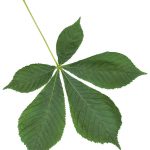 (In lobed or compound leaves) when all lobes or leaflets originate from one central point (as fingers originate from the palm of the hand); = digitate. (Lindley (1832) uses this term only for palmately lobed; Hickey & King (2000) use it only for palmately divided; Stearn (1973) specifies it to mean 5-lobed; generally it can mean either lobed or divided).
(In lobed or compound leaves) when all lobes or leaflets originate from one central point (as fingers originate from the palm of the hand); = digitate. (Lindley (1832) uses this term only for palmately lobed; Hickey & King (2000) use it only for palmately divided; Stearn (1973) specifies it to mean 5-lobed; generally it can mean either lobed or divided).
Describing a leaf which is divided into several lobes.
With the leaflets all borne at the apex of the common petiole, or a leaf with three or more divisions (or leaflet) arising from a common point. Think of “palm” of the hand.
Having a leaf shaped like a hand.
With 3 or more leaflets, nerves, or lobes radiating from a central point.
The major veins radiating from a common point at the base of the blade, as in the maples.
When the organs in question radiate more or less from the point where some other organ is attached; and the lobes of the leaf.
Referring to either compound leaves with more than three parts, with leaflets, arising from one point, as fingers of a hand; or leaf veins arising from the base of the leaf blade in a fan-shaped arrangement. Veins may be palmate only at the base of the blade, becoming pinnate along the upper part of the midrib, or less commonly, all the major veins may arise at the base of the blade.
Refers to a leaf that resembles an open hand, with lobes radiating from a common point at the base.
Divided into lobes or leaflets that spread out from the end of the leaf stalk like the fingers of a hand, as in a maple leaf.
Lobed, veined, or divided from a common point, like the fingers of a hand.
Having lobes radiating from a common point.
Divided into lobes or leaflets that spread out from the end of the leaf stalk like the fingers of a hand, as in a maple leaf. Digitate has much the same meaning.
Describes a compound leaf with several leaflets arising from a common point.
